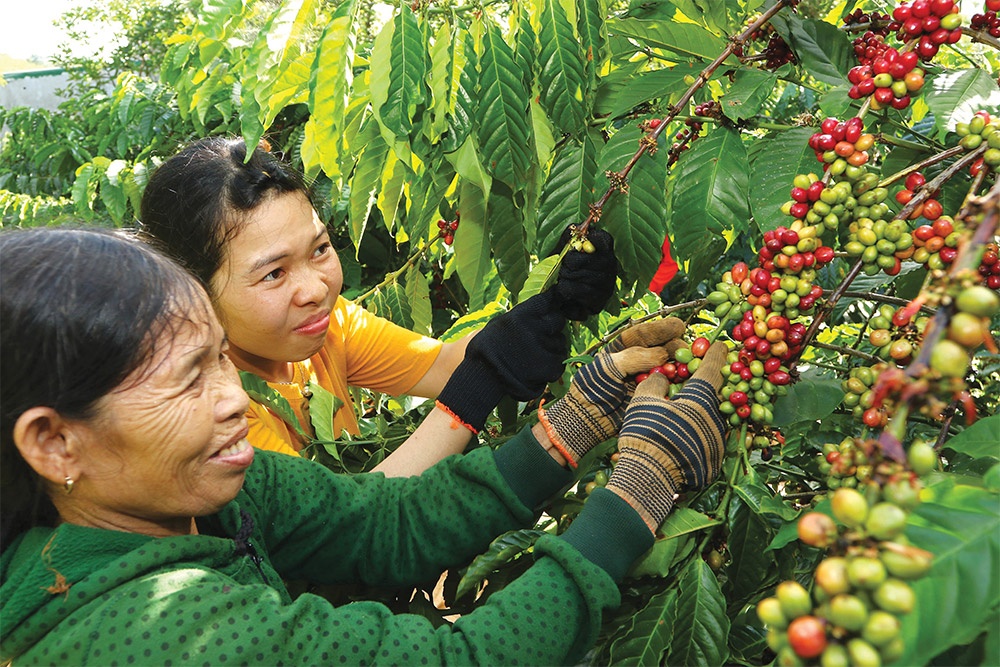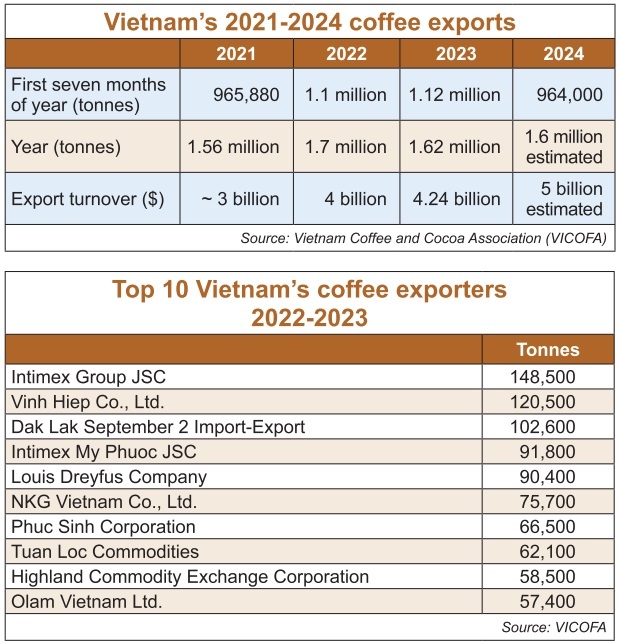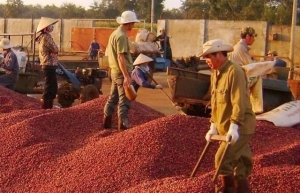Coffee sustainability under pressure
 |
| Despite over 700,000 hectares of coffee land, Vietnam is struggling with finding enough to boost production, photo Le Toan |
The coffee market is expected to continue its waved pattern, as on the trading session of August 28, coffee prices showed signs of increase, approaching around $4.80 per kg compared to $4.60 a few days earlier.
Phan Minh Thong, founder and CEO of Phuc Sinh Group, stated that 2024 has been a year full of surprises and challenges for businesses operating in the coffee industry.
“Coffee prices have surged by 300 per cent since the beginning of this year, causing input costs to increase by 300-400 per cent, but retail prices have not caught up. However, last month, coffee prices declined by 20 per cent in just one week. The unpredictable fluctuations have not only surprised long-standing businesses with more than 20 years of experience in the industry like Phuc Sinh, but many small-scale retailers and coffee roasters will also face a crisis,” Thong said.
Phuc Sinh currently ranks seventh in the top 10 largest coffee exporters in Vietnam, according to the Vietnam Coffee and Cocoa Association (VICOFA). Besides coffee, Phuc Sinh is reported to be the world’s largest pepper exporter, accounting for 8 per cent of all global shipments.
Despite having strong capabilities and a large market, Thong said he was worried that prolonged and erratic price fluctuations may disrupt the sustainable relationships between farmers, suppliers, and importers that have been built over the past 20 years.
“While farmers rejoice in benefiting from the rising coffee prices, coffee roasters face the risk of input costs increasing by three to four times. Many purchase contracts are not fulfilled, causing a crisis of confidence for all supply chains in the coffee industry,” he said.
“The price tension is expected to continue in the last six months of the year and predicted to last for the next five years. I believe that up to 30-40 per cent of mall-scale coffee roasting businesses will go bankrupt,” Thong said.
The data from the General Department of Vietnam Customs showed that coffee exports in July brought in over $381 million, an 18.2 per cent increase compared to the previous month. In the first seven months of this year, coffee exports have generated over $3.6 billion, up by more than 33.5 per cent on-year.
However, according to VICOFA’s prediction, the tension in the supply source is expected to continue due to subjective and objective reasons both domestically and internationally.
Ups and downs
In Brazil, drought in the main coffee-growing region of the southeast is expected to last until mid-September, affecting coffee trees in bloom for the 2025-2026 harvest, and potentially pushing the supply down to a lower level.
In Vietnam, there is a severe drought currently in the Central Highlands, a key coffee-growing region, and the outbreak of diseases has negatively impacted the quality of coffee beans. VICOFA predicts that coffee exports from July to September will gradually decrease, and it will not be until the new harvest begins in October this year that Vietnam’s coffee supply will increase again.
“The impact of climate change globally has significantly reduced the coffee supply worldwide. Coffee prices in the third quarter are forecasted to continue to rise sharply due to the supply shortage, while speculators are starting to hoard goods,” VICOFA chairman Nguyen Nam Hai said.
Vietnam’s coffee production is increasingly affected by prolonged droughts and rising temperatures, which reduces yields and affects crop quality. RMIT senior lecturer in logistics and supply chain management Dr. Majo George said, “This climate-related stress is particularly acute in the Central Highlands, where severe droughts have scorched coffee plantations and exacerbated water scarcity for irrigation.”
Meanwhile, the global supply chain has faced significant disruptions due to container shortages and port congestion, which have delayed shipments and increased costs. These challenges have been worsened by the ongoing geopolitical tensions across the world.
George said, “Such logistical hurdles make it difficult for Vietnamese coffee to reach international markets on time, affecting exporters’ ability to meet demand.”
Inefficiencies in the value chain also pose challenges. Many smallholder farmers in Vietnam still rely on traditional farming methods, leading to inconsistent quality and yields. The lack of advanced post-harvest processing and storage facilities can lead to a significant decline in quality.
“New environmental regulations, particularly from the EU regarding pesticide residues, require adjustments in farming practices and increased costs for compliance. This puts additional pressure on smallholder farmers, who may struggle to adapt quickly,” George added.
Despite having over 700,000 hectares of coffee land, the country is struggling with finding suitable land to further increase production due to concerns about deforestation and the pressure to meet climate-related goals.
Meanwhile, Dr. Devmali Perera, a lecturer in finance at RMIT University, said that many coffee farmers in the country have switched to farming durian due to the rising demand for this fruit in China. This shift has further reduced the area available for coffee production.
“In addition, Vietnamese farmers are experiencing increased cost of production mainly due to the rising prices of fertiliser and labour. The rising domestic prices for coffee have been able to partially compensate farmers for this rising cost of production. However, the increased cost of production has made the life of exporters challenging,” Perera said.
Exporters are now struggling with financial pressures, product shortages, and higher transportation costs, leading to a cautious approach in accepting new orders. Growing demand amid the supply chain constraints creates more price volatility and market uncertainty for coffee, Perera added.
 |
New demand
Growing demand amidst the supply chain constraints creates more price volatility and market uncertainty for coffee, prompting coffee exporters to find more sustainable ways in cultivation and procurement for export.
Nestlé, the third-ranked enterprise in the export of roasted and instant coffee in Vietnam for the 2022-2023 crop year, according to VICOFA’s ranking, is also not exempt from this trend.
Nestlé has positioned Vietnam as a key coffee manufacturing hub, exporting to nearly 30 global markets, including high demanding countries in Asia, Europe, and America.
“The green and digital transformation boosts our sustainable development in Vietnam and enhances our competitiveness,” said Le Thi Hoai Thuong, Nestlé Vietnam’s senior corporate affairs manager.
Since launching the NESCAFÉ Plan in 2011 in the Central Highlands provinces, the company has conducted over 355,000 training sessions on sustainable coffee farming for farmers, supporting an average of more than 21,000 farming households annually.
“The newly launched NESCAFÉ 2030 strategy plan builds on this with a focus on regenerative agriculture, placing farmers at its core,” Thuong added. “Sustainable development is only possible when based on sustainable and responsible sources of raw materials.”
Likewise, Phuc Sinh, after many years of effort in building sustainable growing areas, in August received a $25 million investment from a Dutch investment fund.
The funds will be used to replace machinery at three factories, build a new coffee factory in the Central Highlands province of Dak Nong, and purchase land for constructing additional factories in the future. Additionally, Phuc Sinh also plans to invest in the personnel-management-software system and establish various production standards with thousands of farmers.
“We will announce receiving an investment deal from another non-refundable environmental, social, and governance fund in September. This is a great victory for Phuc Sinh and also the result of outstanding long-term orientation,” said CEO Thong.
Despite ongoing fluctuations, coffee remains a huge potential market, attracting the participation of many enterprises. The scale of the Vietnamese coffee market is estimated to reach over $510 million by the end of 2024 and is projected to exceed $763 million by 2029 with a compound annual growth rate of 8.13 per cent during 2024-2029, according to Indian market research company Mordor Intelligence.
 | Coffee exports exceed 3 billion USD Vietnam's coffee exports has topped 3 billion USD so far this year. |
 | Vietnam seizes gains from soaring coffee prices Vietnamese coffee prices are nearing historic highs on the back of a surge in global coffee prices, creating opportunities for farmers and export businesses. |
 | International demand soars for Vietnamese green coffee beans International demand for Vietnamese green coffee beans has surged in 2024, with total export revenue surpassing $2.4 billion from January to May. |
What the stars mean:
★ Poor ★ ★ Promising ★★★ Good ★★★★ Very good ★★★★★ Exceptional
Related Contents
Latest News
More News
- Businesses ramp up production as year-end orders surge (December 30, 2025 | 10:05)
- Vietjet chairwoman awarded Labour Hero title (December 29, 2025 | 13:06)
- How to unlock ESG value through green innovation (December 29, 2025 | 10:03)
- AI reshapes media and advertising industry (December 29, 2025 | 08:33)
- FPT and GELEX sign deal to develop blockchain tech for global markets (December 29, 2025 | 08:29)
- Vietnam’s GDP forecast to grow by 9 per cent in 2026 (December 29, 2025 | 08:29)
- Women entrepreneurs are key to Vietnam’s economic growth (December 29, 2025 | 08:00)
- Vietnam's top 500 value-creating enterprises announced (December 27, 2025 | 08:00)
- The PAN Group shaping a better future with ESG strategy (December 26, 2025 | 09:00)
- Masan Consumer officially lists on HSX, marking the next phase of value creation (December 25, 2025 | 13:20)

 Tag:
Tag:




















 Mobile Version
Mobile Version